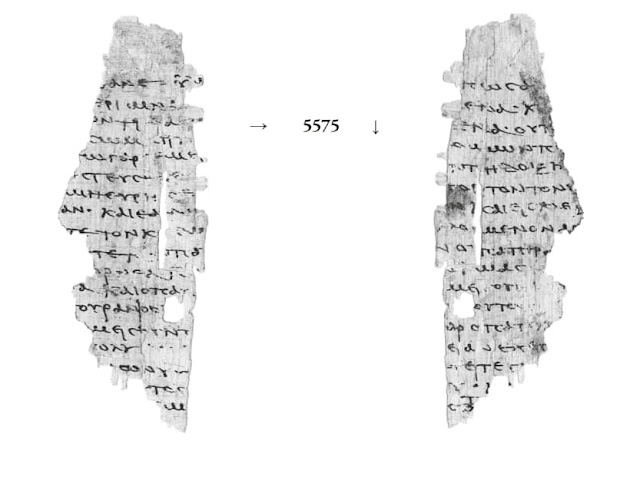Volume 87 of the Oxyrhynchus Papyri is apparently out today and it lists some pretty exciting papyri. From the website:
This volume includes editions of fifty-eight papyri and one text on parchment. Among the theological texts, three are of exceptional interest. 5575 is an early copy of sayings of Jesus corresponding in part to the canonical gospels of Matthew and Luke and in part to the apocryphal gospel of Thomas. Jesus is also the speaker in 5576 and apparently in 5577, where Mary is addressed. Both pieces may be loosely called “Gnostic”; the latter appears to be Valentinian.
Candida Moss has more detail at the Daily Beast here. From her article:
The significance of the fragment lies in its date and contents. In conjunction with distinguished papyrologist and paleographer Ben Henry, the editors—Jeffrey Fish, Daniel Wallace, and Michael Holmes—date the fragment to the second century CE. This is important because, as Dr. Fish told me, “Only a few gospel papyri can be securely dated to the second or beginning of the third century.” This is the earliest period from which we have Christian manuscripts. “What is so significant about this papyrus,” continued Fish, “is that it contains sayings of Jesus which correspond partly to canonical gospels (Matthew and Luke) and partly to sayings we know only from the Gospel of Thomas. It is as early or earlier than any of our papyri of the Gospel of Thomas [our earliest non-canonical Gospel],” including other fragments of the Gospel of Thomas found at Oxyrhynchus.
I will update this post as I learn more. But needless to say, this looks like a big deal.
Update (9/1/23)
Now that I’ve seen pictures and emailed the editors I can confirm this is the fragment I worked on as a student in the Green Scholars Initiative back around 2012. It was a treat to work on it and I’m very glad to see it finally published. I did get to spend an afternoon with the fragment. I’ll try to publish some more of the work I did on it back then later on the blog. I haven’t seen the official publication yet and, naturally, the editors went well beyond my meager student efforts. You’ll notice that comparing the photos from 2013 to the b/w images from the Oxy volume that another piece of the fragment was identified. So the color photos do not show the entire known fragment.




Exciting!
ReplyDeleteHow interesting Peter! Can you tell us more about your experience working on the fragment as a student? Where and when it happened, who supervised you etc.?
ReplyDeleteThe extra bit in the black/white images is interesting in light of the way P129 and P131 were once split between the Stimer and MOTB collections.
ReplyDeleteGood catch. The fragment is larger in the 2023 photos than it is in the 2013 photos. Does this mean that the little corner piece was found since 2013 and reattached to the larger fragment for the 2023 photos?
DeleteWould this dating be another challenge to Perrin's theory on Thomas' dependence on the Diatessaron?
ReplyDeleteNot the dating Ben, the content itself. Perrin's theory was based on the English translation of Thomas to begin with and he treated the multitude of Coptic-Greek "homonyms" like one and the same, whereas the Greek loanwords that have a cultivation equivalent in Thomas all convey a bigger metaphysical meaning:
ReplyDeletePlace ⲧⲟⲡⲟⲥ Noun 4, 24, 60, 64, 68
place ⲙⲁ Noun masculine 12, 18, 22, 30, 33, 50, 65, 67, 68, 75, 76, 86, 99
These two words have completely different applications, and I have capitalised the Greek in that regard in my Translation - and there are many others like this pair
On topic again: Thomas lies at the root of all of Christianity - and what comes before that; this is a perfect example, as I argue that this is Marcion.
I might be wrong about the conclusion, I may be right about my reconstruction and analysis:
https://www.academia.edu/106297440
On mobile, my apologies - the response kept jumping up and down.
ReplyDeletecultivation = Coptic
bigger = higher
Long live autocorrect :/
Greek pOxy 5575 may be another hint that gThomas was originally written in Greek. Presumably, Marcion did not write in Coptic.
DeleteYet, Martijn Linssen, do you, having associated this ms with Marcion, still think that gThomas was originally written in Coptic?
I missed this comment, Stephen. As always, you don't engage with the material I provide yet only posit a tentative question; no surprises there!
DeleteYet perhaps my latest can convince you: https://works.hcommons.org/records/1v9a0-39q84
(Greek-Coptic word twins in GoT express various shades of meaning)
Am I correct in seeing no (zero) nomina sacra in the extant text?
ReplyDeleteIndeed, it seems P.Oxy.5575 has no nomina sacra in the extant text.
DeleteDo I understand right that text does contain two words which would usually be written as nomina sacra (Father, Heaven). So either the author doesn't use nomina sacra at all, or they just don't use those specific ones. How unusual would it be for a text at the time not to use nomina sacra for Father?
DeleteThat would not be a big deal.
Delete